It is tomato season and you need to pay good attention to your tomato plants! What they need is timely pruning and topping. Here are 3 reasons to prune your tomato fruit plant…
With pruning your tomatoes have improved airflow and catch fewer diseases…
When you prune plants, they have fewer leaves all over, which allows for more air to move through them. Also, the leaves dry faster after showers, so they are less vulnerable to the diseases that need prolonged moisture to develop — which is something very helpful in wet climates. Plus, not so dense leaves make it easier to spot insect pests that could be concealed by a thick canopy.
With pruning your tomatoes yield bigger fruits…
Another asset of pruning at the right time is that it directs energy toward producing and ripening fruit, instead of producing a ‘head of leaves.’ Although you will probably have fewer fruits on a pruned plant, they will be bigger for sure! Since pruned bushes can be grown quite closer to one another because the growth is vertical, you will have extra room for additional plants to make up the difference in harvest numbers.
With pruning your tomatoes ripen earlier…
As a rule of the thumb, when a plant has fewer fruits to take care of, that fruit ripensfaster. This can be really helpful in short-season climates, where getting a tomato harvest is often a ‘rat race’ against time and changeable weather conditions.
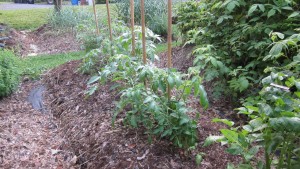
When is the best time to start pruning of your tomatoes?
You can begin with pruning your tomatoes any time once they have reached 12-18 inches (30-46cm) in height. Simply remove young suckers while they are in the bud and you can pinch them cleanly off.
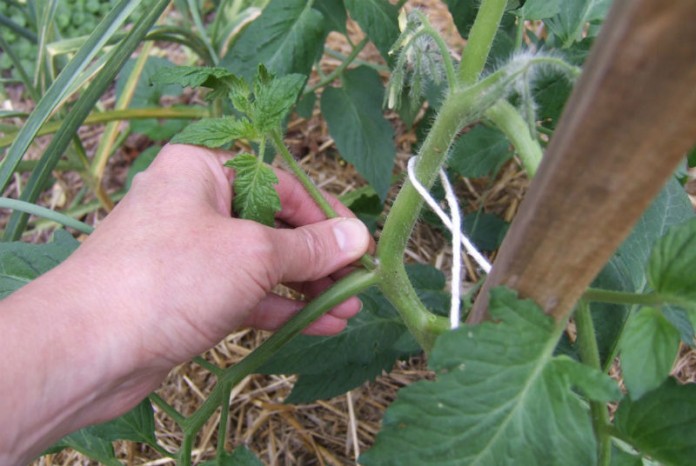
Do you like to ‘train’ your plants and check up on them day after day?
If so, then you may have a natural bent to be a tomato pruner! Pruning tomato plants is an optional technique that many experienced gardeners practice to keep their plants tidy, manipulate fruit size, and even speed up ripening.
There is one big catch here: You should only prune indeterminate varieties, which continuously produce new leaves and flowers throughout the growing season. If you prune only determinate varieties, you can surely reduce the harvest…
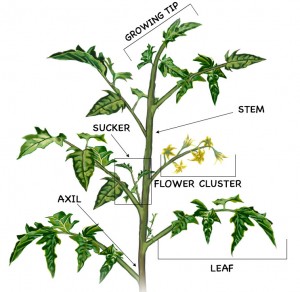
Now let’s learn what the different parts of a tomato plant are called…
Pruning works best for plants trained on a strong vertical support, such as a trellis or stake (see the photo below). In this way, it is easy to both see what you are doing and keep the main stems carefully-controlled by tying them to a single support. On the other hand, cages naturally gather all of the limbs and support them without much attention from the gardener, so there is no actual need to prune.
Either way, the key is to prune enough, but not too much, so that the fruit receives both adequate sugars from the leaves and enough cover from the sun.
A WORD OF CAUTION: Don’t prune tomatoes when leaves are wet, as doing so can help spread a disease.
How To Prune Tomatoes – Indeterminate Varieties Only!
You will need to prune tomatoes throughout the season to maximize the harvest. It is not that difficult once you get into the habit of it. So, here’s a season-wise guidance what to do and when:
1. Pruning at tomato planting
Remove the lower leaves when planting so that your plants can be deep-rooted in the soil. If you are into planting a Bonnie plant, follow the directions on the wrapper.
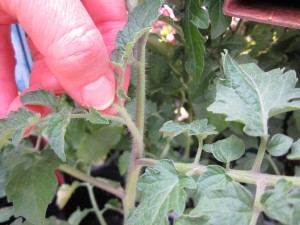
To do the Missouri pruning technique on suckers, pinch off the growing tip, leaving only the 2 lowest leaves. Remove any flowers present at planting time (even if they were there when you bought the plant), which helps the energy to go into leafy growth instead of fruiting at this early stage.
2. Early/Mid-Season tomato pruning
Remove flowers until plants are 12-18 inches (30-46cm) tall, to help plants direct more energy to the roots. Remove all leafy suckers as well beneath the first fruit cluster so that they won’t slow down the development of the fruit.
Suckers are the little shoots that form in the spot (called an axil) where the leaf stem attaches to the main growing stem. In the cold northern regions, many gardeners go even further, removing all suckers as they appear. In warmer regions though, experts often recommend practicing what is called Missouri pruning, where you pinch off the leaflets on the end of each sucker, leaving only the 2 base leaflets in place.
As these leaves enlarge, they help shade fruits and protect them from sun scorch. So try to remove suckers when they are small enough to easily pinch off with your fingers, so you don’t leave a big gaping wound on the stem.
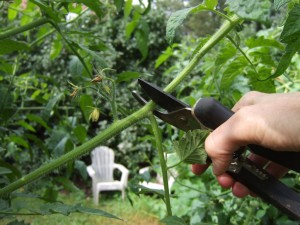
But if you do have to cut them, use a sharp knife or a pruner blade to make a clean cut as close to the main stem as possible while not damaging the stem tissue. And ‘top’ plants for faster late-season ripening by removing growing tips about a month before the first frost.
3. Late season tomato pruning
Tomato plants are often still loaded with fruits as the growing season draws to a close. To speed up their ripening late in the season, remove the growing tip of each main stem about a month before the first frost in the fall is expected.
This type of pruning called topping causes the plant to stop flowering and setting new fruit, and instead it directs all sugars to the remaining fruit. This way, the fruit will ripen faster, plus it becomes more likely that you will pick the green tomatoes beforefrost and they will actually ripen when you bring them indoors.
It may be hard to bring yourself to do this, but it will be worth doing if you wish ripe tomatoes! Of course, if you prefer your tomatoes to remain green for use in frying and jelly, you can certainly skip this trimming.
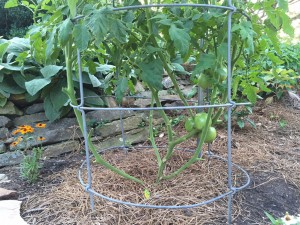
To help improve airflow and avoid the chance of diseases, remove the leaves along the bottom 12 inches (30 cm) of the stems of indeterminate tomato plants.
What if you already have big plants in the garden?
Even if growing and pruning to a vertical stake may be not be your option for this year,both determinate and indeterminate varieties benefit from removing the lower leaves to keep soil-borne diseases from splashing up onto the foliage. Especially if you already see leaf spots and blotches on the lower leaves!
So clip away any leaves that are touching the soil and continue pruning up to a foot (30 cm) from the ground. Many tomato diseases, including septoria and early blight, are present in soils, especially in the regions of Northeast, Mid-Atlantic and upper Midwest. As plants get taller, you can continue removing lower leaves up to 18 inches (46cm) from the ground, to help keep the disease from spreading.
Work when the leaves are dry to prevent spreading the disease. For (tomato) plants supported by cages, you can remove some leaves from the center of the plant to increase airflow, which can help prevent and/or slow down disease outbreaks.
Research has shown that leaves nearest a fruit cluster are the ones that send sugar to that fruit, so when ‘thinning’, do not remove leaves directly above and below the fruit cluster.
You will get 2 rewards with this technique:
1. Leaves above the fruit cluster can help shade the ripening fruit, and
2. Leaves below the fruit cluster can send sugars to it.
Source: University of Kentucky Cooperative Extension Service.
If you like this idea, be sure to share it with your friends and inspire someone you know. Anything becomes possible with just a little inspiration…
